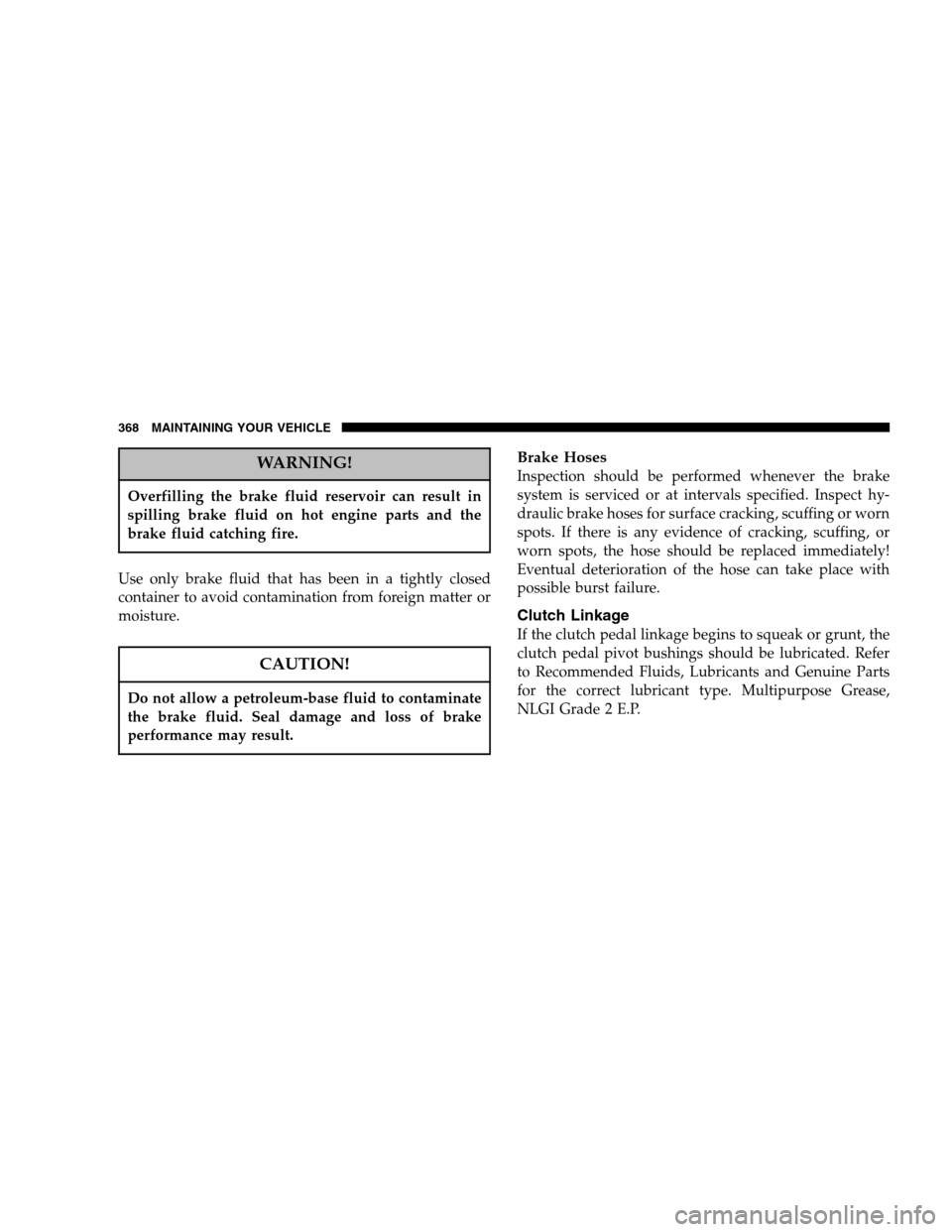Page 368 of 448

WARNING!
Overfilling the brake fluid reservoir can result in
spilling brake fluid on hot engine parts and the
brake fluid catching fire.
Use only brake fluid that has been in a tightly closed
container to avoid contamination from foreign matter or
moisture.
CAUTION!
Do not allow a petroleum-base fluid to contaminate
the brake fluid. Seal damage and loss of brake
performance may result.
Brake Hoses
Inspection should be performed whenever the brake
system is serviced or at intervals specified. Inspect hy-
draulic brake hoses for surface cracking, scuffing or worn
spots. If there is any evidence of cracking, scuffing, or
worn spots, the hose should be replaced immediately!
Eventual deterioration of the hose can take place with
possible burst failure.
Clutch Linkage
If the clutch pedal linkage begins to squeak or grunt, the
clutch pedal pivot bushings should be lubricated. Refer
to Recommended Fluids, Lubricants and Genuine Parts
for the correct lubricant type. Multipurpose Grease,
NLGI Grade 2 E.P.
368 MAINTAINING YOUR VEHICLE
Page 370 of 448

Transfer Case — If Equipped
Fluid Level Check
This fluid level can be checked by removing the filler
plug. The fluid level should be to the bottom edge of the
filler plug hole with the vehicle in a level position.
Lubricant Selection
Refer to Recommended Fluids, Lubricants and Genuine
Parts for the correct lubricant type.
Manual Transmission — If Equipped
Fluid Level Check
This fluid level can be checked by removing the filler
plug. If the level of the lubricant is more than 1/4” below
the bottom of the filler hole while the vehicle is on level
ground, enough lubricant should be added to bring the
level to the bottom of the filler hole.
Lubricant Selection for 6-Speed Manual
Transmission — If Equipped
If it becomes necessary to add fluid or change the fluid,
be sure to use the same lubricant or equivalent. Refer to
Recommended Fluids, Lubricants and Genuine Parts for
the correct lubricant type.
Automatic Transmission
Fluid Level Check
The fluid level should be checked when the engine is
fully warmed up and the fluid in the transmission is at
normal operating temperature. Operation of the trans-
mission with an improper fluid level will greatly reduce
the life of the transmission and of the fluid. Check the
fluid level whenever the vehicle is serviced.
370 MAINTAINING YOUR VEHICLE
Page 371 of 448

Procedure For Checking Fluid Level
To properly check the automatic transmission fluid level,
the following procedure must be used:
1. The vehicle must be on level ground.
2. The engine should be running at curb idle speed for a
minimum of 60 seconds.
3. Fully apply parking brake.
4. Place the gear selector briefly in each gear position
ending with the lever in N (Neutral).
5. Remove the dipstick and determine if the fluid is hot
or warm. Hot fluid is approximately 180°F (82°C) which
is the normal operating temperature after the vehicle has
been driven at least 15 miles. The fluid can not be
comfortably held between the finger tips. Warm is when
fluid is between 85° - 125°F (29° - 52°C).6. Wipe the dipstick clean and reinsert until seated.
Remove dipstick and note reading.
a. If the fluid is hot, the reading should be in the
crosshatched area marked “OK”.
b. If the fluid is warm, the reading should be between
the two holes. If the fluid level indicates low, add
sufficient fluid to bring to the proper level.
Fluid is added through the dipstick tube.
NOTE:To prevent dirt and water from entering the
transmission after checking or replenishing fluid, make
certain that the dipstick cap is properly seated.
Selection Of Lubricant
Refer to Recommended Fluids, Lubricants and Genuine
Parts for the correct lubricant type. It is important that the
transmission fluid be maintained at the prescribed level
using the recommended fluid.
MAINTAINING YOUR VEHICLE 371
7
Page 376 of 448

Tampering With Noise Control System Prohibited
Federal law prohibits the following acts or the causing
thereof: (1) the removal or rendering inoperative by any
person, other than for purposes of maintenance, repair, or
replacement, of any device or element of design incorpo-
rated into any new vehicle for the purpose of noise
control prior to its sale or delivery to the ultimate
purchaser or while it is in use, or (2) the use of the vehicle
after such device or element of design has been removed
or rendered inoperative by any person.
Among those acts presumed to constitute tampering are
the acts listed below.
•AIR CLEANER
�Removal of the air cleaner.
�Removal of the air cleaner filter element from the air
cleaner housing.
�Removal of the air ducting.
•EXHAUST SYSTEM
�Removal or rendering inoperative exhaust system
components including the muffler or tailpipe.
•ENGINE COOLING SYSTEM
�Removal or rendering inoperative the fan clutch.
�Removal of the fan shroud.
Noise Emission Warranty
The manufacturer warrants that this vehicle as manufac-
tured by the manufacturer, was designed, built and
equipped to conform at the time it left the manufacturer’s
control with all applicable U.S. EPA Noise Control Regu-
lations.
This warranty covers this vehicle as designed, built and
equipped by the manufacturer, and is not limited to any
particular part, component or system of the vehicle
manufactured by the manufacturer. Defects in design,
376 MAINTAINING YOUR VEHICLE
Page 383 of 448
Seat Belt Maintenance
Do not bleach, dye or clean the belts with chemical
solvents or abrasive cleaners. This will weaken the fabric.
Sun damage will also weaken the fabric.
If the belts need cleaning, use a mild soap solution or
lukewarm water. Do not remove the belts from the car to
wash them.
Replace the belts if they appear frayed or worn or if the
buckles do not work properly.
FUSE AND RELAY CENTER
Your vehicle is equipped with a fuse and relay center
located in the engine compartment near the battery.
Located on the underside of the cover is a label that
identifies each component.
1. Disconnect the battery negative (-) cables from the
right and left batteries before removing the cover.
MAINTAINING YOUR VEHICLE 383
7
Page 384 of 448

2. Use specified fuses only.
3. Always properly reinstall the cover.
VEHICLE STORAGE
If you are storing your vehicle for more than 21 days, we
recommend that you take the following steps to mini-
mize the drain on your vehicle’s battery:
•Disconnect the Ignition-Off Draw fuse (I.O.D.) fuse
located in the Fuse and Relay Center, located in the
engine compartment. The I.O.D. cavity includes a
snap-in retainer that allows the fuse to be discon-
nected, without removing it from the fuse block.
•The electronic shift transfer case should be placed in
the 4HI mode and kept in this position to minimize the
battery drain.
•As an alternative to the above steps you may, discon-
nect the negative cables from both batteries.
REPLACEMENT LIGHT BULBS
LIGHT BULBS — Inside Bulb No.
Overhead Console Lights............... TS212-2
Dome Light............................7679
All of the inside bulbs are brass or glass wedge base.
Aluminum base bulbs are not approved.
LIGHT BULBS — Outside Bulb No.
Back-Up..............................3057
Center High Mounted Stop Lamp............. 912
Fog Lamp...........................9006LL
Headlamp (Halogen)...................9007QL
Park & Turn Signal...................3157NAK
Rear License Plate Lamp................... 168
Rear Cargo Light......................... 912
Tail & Stop............................3057
Cab Clearance Lights...................... 168
Dual Rear Wheel Sidemarker Light............ 168
Dual Rear Wheel Tailgate ID Lights (3)......... 168
384 MAINTAINING YOUR VEHICLE
Page 397 of 448
2. Pull bulb straight from the connector.
3. Reverse procedure for installation of bulbs and hous-
ing.FLUID CAPACITIES
FLUID CAPACITIES U.S. Metric
Fuel
2500 Shortbed Models 34 gal. 128L
2500 Longbed Models 35 gal. 132L
3500 Shortbed Models 34 gal. 128L
3500 Longbed Models 35 gal. 132L
Engine Oil
5.9L Diesel Engine I-6 12.0 qts. 11.4L
Cooling System
5.9L Diesel Engine I-6 7 gal. 26.5L
MAINTAINING YOUR VEHICLE 397
7
Page 398 of 448
RECOMMENDED FLUIDS, LUBRICANTS AND GENUINE PARTS
Engine
Component Fluids, Lubricants and Genuine Parts
Engine Coolant Mopar�Antifreeze/Coolant 5 Year/100,000 Mile Formula HOAT (Hybrid Or-
ganic Additive Technology) P/N 5011764AB or equivalent.
Engine Oil For the proper quality and SAE Grade oil for your engine, refer to the section
�Maintenance Procedures.�
Engine Oil Filter Mopar�Engine Oil Filter, P/N 05083285AA or equivalent.
Engine Fuel Filter Mopar�Fuel Filter, P/N 05015581AB or equivalent.
Fuel Selection Refer to the section�Fuel Requirements�for detailed information on fuel se-
lection.
398 MAINTAINING YOUR VEHICLE